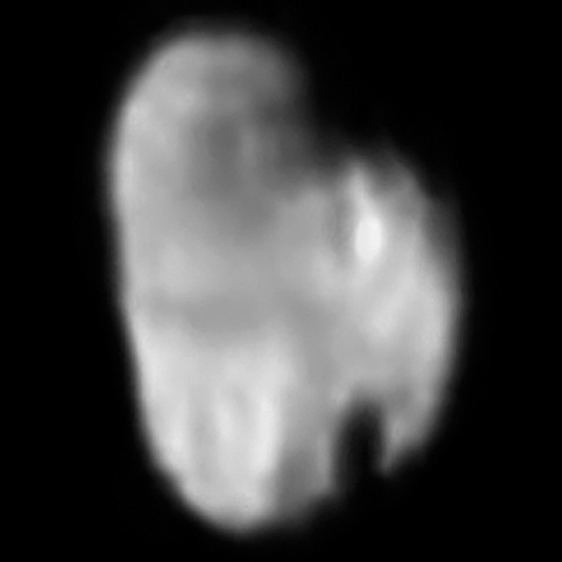Discovery date 15 June 2005 | Pronunciation /ˈhaɪdrə/ Adjectives Hydrian | |
 | ||
Discovered by Hubble Space TelescopePluto Companion Search Team Alternative names (7005134340000000000♠134340) Pluto III | ||
Hydra is the outermost known moon of Pluto. It was discovered along with Nix in June 2005, and was visited along with Pluto by New Horizons in July 2015. Hydra's surface is probably covered with water ice. Observed within Hydra's bright regions is a darker circular structure with a diameter of approximately 10 kilometers (5 miles). Hydra's reflectivity (the percentage of incident light reflected from the surface) is intermediate between those of Pluto and Charon.
Contents
Discovery
Hydra was discovered by the Hubble Space Telescope's "Pluto Companion Search Team", consisting of Hal A. Weaver, Alan Stern, Max J. Mutchler, Andrew J. Steffl, Marc W. Buie, William J. Merline, John R. Spencer, Eliot F. Young, and Leslie A. Young. The discovery images were taken on 15 May 2005, and 18 May 2005; Nix and Hydra were independently discovered by Max J. Mutchler on 15 June 2005, and Andrew J. Steffl on 15 August 2005. The discoveries were announced on 31 October 2005, after confirmation by precoveries from 2002. They were provisionally designated S/2005 P 1 (Hydra) and S/2005 P 2 (Nix).
Name
The name Hydra was announced on 21 June 2006, in IAU Circular 8723, along with the formal designation Pluto III. The name is that of the Hydra, the nine-headed serpent that battled Heracles in Greek mythology. The nine heads of Hydra are a reference to Pluto's tenure as the ninth planet; its initial, H, refers to the Hubble Telescope, which discovered Hydra and, together with Nix, to the New Horizons mission whose safe passage was the motivation for taking the Hubble images.
Orbital properties
Hydra orbits the barycenter of the system in the same plane as Charon and Nix, at a distance of about 65,000 km. Its eccentricity of 0.0059 is small, but significantly non-zero, and the largest of those of Pluto's small moons (slightly larger than that of Styx).
Hydra is in a 2:3 orbital resonance with Nix, and a 6:11 resonance with Styx (the ratios represent numbers of orbits completed per unit time; the period ratios are the inverses). As a result of this "Laplace-like" 3-body resonance, it has conjunctions with Styx and Nix in a 5:3 ratio.
Its orbital period of 38.2 days is also close to a 1:6 orbital resonance with Charon, with the timing discrepancy being 0.3%. A hypothesis to explain the near-resonance is that it originated before the outward migration of Charon following the formation of all five known moons, and is maintained by the periodic local fluctuation of 5% in the Pluto–Charon gravitational field strength.
Like Saturn's moon Hyperion, Nix, and the other small moons of Pluto, Hydra rotates chaotically; its day length and rotational axis vary quickly over astronomical timescales, to the point that it regularly flips over. This is largely due to the aforementioned fluctuation of the Pluto–Charon gravitational field, as well as its irregular shape. Hydra's current rotational period is a mere 10 hours.
Physical properties
Hydra is irregular in shape, 55 by 40 kilometers (34.2 mi × 24.9 mi) in cross-section from one side. It is spectrally neutral like Charon and most of Nix (whereas Pluto is reddish) and is composed primarily of water ice, probably ice XI.
Exploration
The only detailed photographs of Hydra were taken by the New Horizons spacecraft from approximately 640,000 kilometres (400,000 mi) away during its flyby of the Pluto–Charon system on 14 July 2015. It also studied Hydra's surface composition, reflectivity, and other basic physical properties. Hydra's reflectivity is estimated to be about 45 percent.
